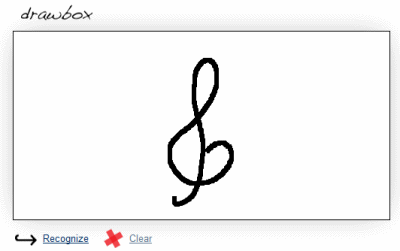LaTeX users may know about Detexify, a website that lets you draw a character then looks up its TeX command. Now there’s a new site Shapecatcher that does the same thing for Unicode. According to the site, “Currently, there are 10,007 Unicode character glyphs in the database.” It does not yet support Chinese, Japanese, or Korean.
For example, I drew a treble clef on the page:

The site came back with a list of possible matches, and the first one was what I was hoping for:

Interestingly, the sixth possible match on the list was a symbol for contour integration:

Notice the treble clef response has a funny little box on the right side. That’s because my browser did not have a glyph to display that Unicode character. The browser did have a glyph for the contour integration symbol and displayed it.
Another Unicode resource I recommend is this Unicode Codepoint Chart. It is organized by code point value, in blocks of 256. If you were looking for the contour integration symbol above, for example, you could click on a link “U+2200 to U+22FF: Mathematical Operators” and see a grid of 256 symbols and click on the one you’re looking for. This site gives more detail about each character than does Shapecatcher. So you might use Shapecatcher to find where to start looking, then go to the Unicode Codepoint Chart to find related symbols or more details.
Other posts on Unicode
- Why Unicode is subtle
- The disappointing state of Unicode fonts
- Entering Unicode characters in Windows and Linux

I’ve keybound gucharmap, but this will definitely be helpful at some point in the future.
Related factoid: the g-clef character is a fantastic test codepoint for code that claims to accept Unicode input. It requires more than 16-bits to represent in Unicode and a lot of software explicitly or accidentally assumes that all codepoints will be in the range 1 … 65535. For example, the “.” metacharacter in Python’s re module only matches things less than 65536.
No special reason to use the g-clef here, except it’s easy to remember.
Hmm… Can’t get it to output a C clef though…
Christopher: I didn’t try that, but I tried an interrobang. I couldn’t draw it well enough for the software to distinguish my drawing from the letter p and similar symbols.
Why is there an arrow inside the circle that indicates it’s a closed contour?
I’ve never seen that before… it’s damn ugly, and it even points the *wrong way*.
does not seem to be ipad-friendly
Ophu: Someone recommended this app that presumably is iPad-friendly.
Unicode glyphs made easy. Thanks